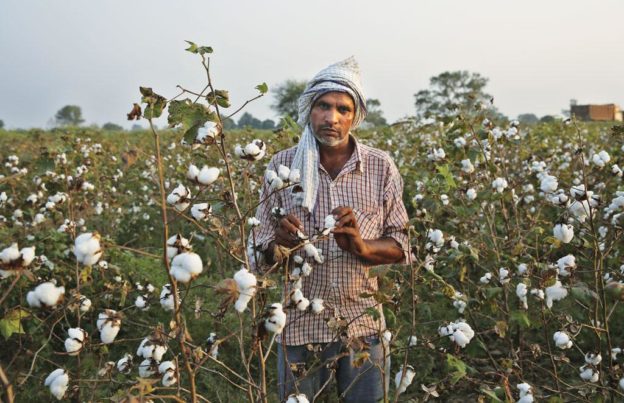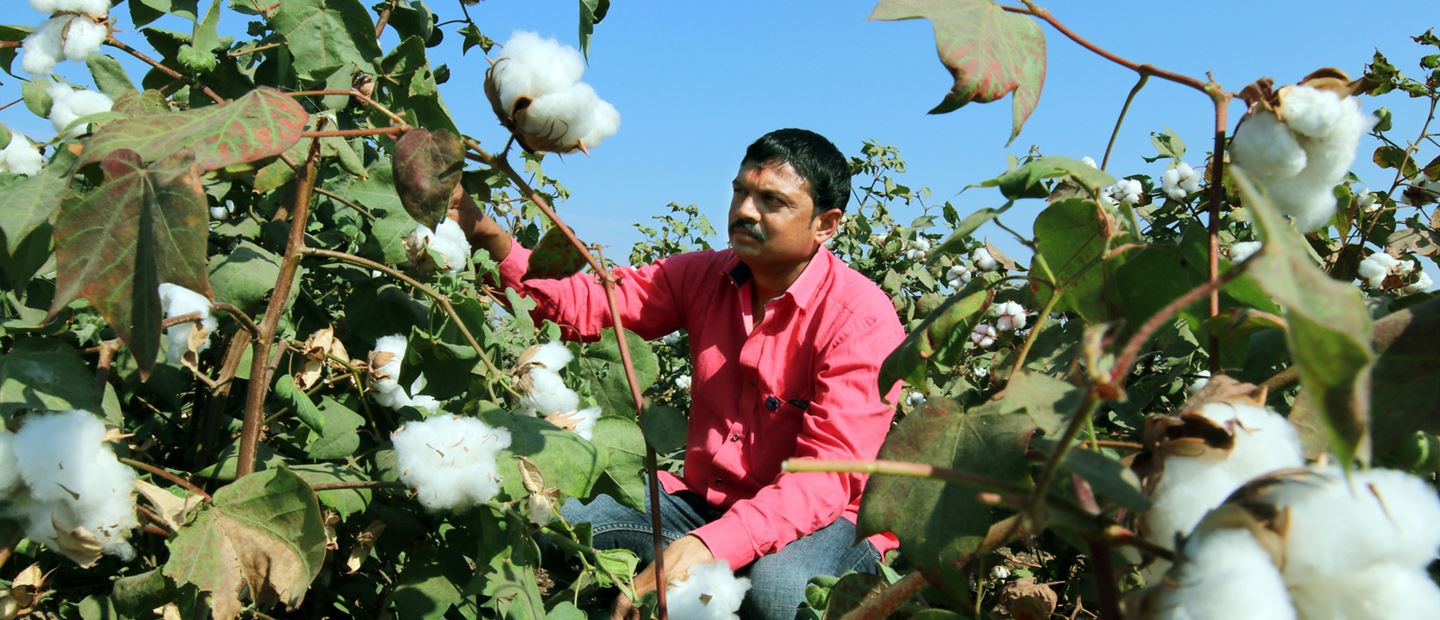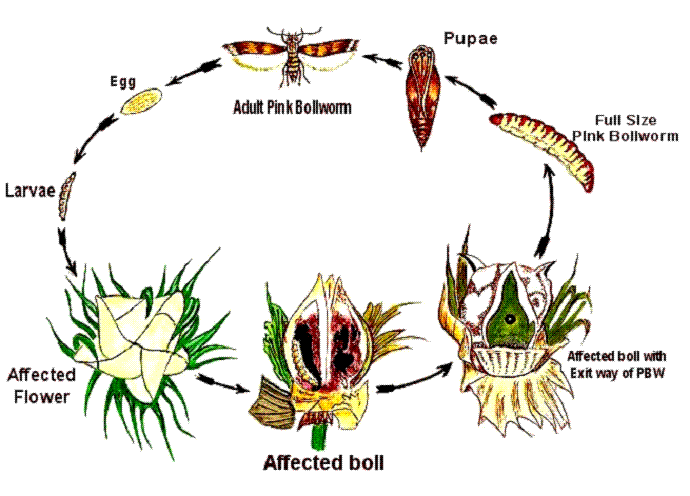The cotton plant has perhaps the most complex structure of all major field crops. Its indeterminate growth habit and extreme sensitivity to adverse environmental conditions is unique. The growth of the cotton plant is very predictable under favourable moisture and temperature conditions. Growth follows a well-defined and consistent pattern expressed in days. Another useful and more precise way to assess crop development relies on using daily temperatures during the season to monitor progress.
The heat unit concept utilizes accumulated hours above a critical temperature rather than calendar days in describing growth and development. The growing degree days (DD) concept is based on a developmental threshold above which the crop grows. Below that temperature is where little or no development occurs. For cotton, the threshold temperature is 60˚F; therefore, the degree days are referred to as “DD60’s”.
Developmental Stages of Cotton Crop
Root Development- Under favourable germination conditions, the radicle (root) emerges within two to three days. The radicle becomes the taproot that grows downward into the soil. The taproot penetrates the soil rapidly after germination and may reach a depth of up to 10 inches or more by the time the cotyledons unfurl (5 to 7 days)
Vegetative Development
Cotton seedlings emerge five to ten days after planting or after 50 to 60 DD60s are accumulated. The fully expanded cotyledons are 1 to 2 inches above the soil surface and are arranged directly opposite the main stem. The cotton plant has a very prominent main stem, which results from the elongation and development of the terminal bud or apical meristem. The main stem consists of a series of nodes and internodes and has an indeterminate growth habit.
Reproductive Development
Signs of reproductive growth begin to appear about four to five weeks after planting with the formation of the floral buds or squares in the terminal of the plant. Cotton has a distinctive and predictable fruiting pattern. Once fruiting begins, fruiting branches tend to be produced at each successive main-stem node. The first fruiting branch is often produced at the sixth or seventh node on the main stem. Approximately three days elapse between fruit on a given fruiting branch and the same relative position on the next higher branch.
About Pink Bollworm
Common name Pink bollworm
Local name Gulabi sundi/gulabi illi/gulabi bond ali
Scientific name Pectinophora gossypiella Saund
Family Gelechiidae
Order Lepidoptera
Pest category Borer
Weather conditions for pest attack
Maximum temperature greater than 330C, morning relative humidity less than 70 %, evening relative
humidity greater than 40 % during the standard weeks of 40, 41 and 43, and less than 12°C minimum temperature between 48 and 49, respectively result in P. gossypiella severity.
The life cycle of pink bollworm
Eggs- Eggs are pearly iridescent white, flattened, oval measuring approximately 0.5 mm long, 0.25 mm wide and sculptured with longitudinal lines. Eggs are laid singly or in groups of four to five.
Larva- First two instars are white, while from third instar pink colour develops. The larvae have the characteristic dark brown head due to the sclerotised prothoracic shield.
Pupa- Pupae are light brown when fresh, gradually become dark brown as the pupation proceeds. Pupa measures up to 7 mm in length.
Adult- The adult moth is greyish brown with blackish bands on the forewings and the hind wings are silvery grey. Moths emerge from pupae in the morning or in the evening, but are nocturnal, hiding amongst soil debris or cracks during the day.
Pink Bollworm attack on cotton
Early in the season, eggs are laid in any of the sheltered places of the plant axis of petioles or peduncles, the underside of young leaves, on buds or flowers. Once the bolls are 15 days old, these become favoured sites for oviposition. Incubation period is 3-6 days. First two instars are white, while from third instar pink colour develops.
Larval cycle lasts for 9-14 days in hotter regions. The mature larvae are either ‘short-cycle’ and will go on to pupate or ‘long cycle’ to enter a state of diapause. While the former is the observed phenomenon in South India, diapause is seen in the North and Central parts of India. Short cycle larvae pupating may cut a round exit hole through carpel wall and fall to ground or may tunnel the cuticle, leaving it as a transparent window and pupate inside. Pupation is inside a loose-fitting cocoon with a highly webbed exit at one end. Pupal period ranges between 8 and 13 days. The life cycle is completed in 3-6 weeks.
Late season has invariably overlapping broods. The long cycle larvae entering diapause, spins a tough thick walled, closely woven, spherical cell referred as “hibernaculum” with no exit hole. Always, the long term larvae occur during end of crop season, where there are mature bolls present and larvae often form their hibernacula inside seeds. Hibernacula may occupy single seeds or double seeds. P. gossypiella hibernate as full fed larvae during cold weather. Diapause larvae often spin up in the lint of an open boll and if still active in ginnery, will spin up on bales of lint, bags of seed or in cracks and crevices. Moths emerging from the hibernating larvae are long lived with females and males alive for 56 and 20 days, respectively.
Pink bollworm damage in cotton
Larva when attacks the bud of less than 10 days old, shedding of bud occurs and larva dies. But with older bud, larva can complete development. There can be surely pink bollworm infestation on bolls but there need not be any shedding. Larva in flower bud spins webbing that prevents proper flower opening leading to “rosetted-bloom”. Ten to twenty days old bolls are attacked from under bracteoles. Larvae feed on the developing seeds. While in younger bolls entire content may be destroyed, in older bolls development could be completed on three to four seeds. Interloculi movement is also seen. Several larvae can infest a single boll.
Pink bollworm damage symptoms in cotton
Rosetted flower ‘ (improper opening of petals) is typical of bollworm attack. Small exit holes (smaller than the feeding holes of other two bollworms viz., Earias & Helicoverpa) are seen on developing green bolls. Stained lint around feeding areas resulting in bad quality kapas is seen in open bolls. Improper boll opening with damaged seeds are obvious. Small round holes are seen on the septa between locules of open bolls. Lint of pink bollworm attacked bolls is of inferior quality.
Cultural and mechanical control of pink bollworm in cotton
- Burn all trash collected during the ginning process. Remove all seed from the ginneries by the end of April. Fumigate the seed left uncrushed in the mills before end of May with Aluminium Phosphide @ one 3-g tablet per cubic metre space, giving an exposure of 48 hours or use two tablets with an exposure of 24 hours. No un-fumigated seed should be retained or sold by the ginneries. Only cotton-seed cake (khal), should be fed up the cattle and no seed should be kept for this purpose.
- The Seed meant for sowing should be acid-delinted in the ginneries before it is sold. The acid-treatment kills the larvae of the pink bollworm and bacterial pathogen of bacterial blight. It also removes fuzz and there by facilitates Mechanical sowing.
- Even the apparently healthy seed-cotton (kapas) may be harbouring larvae of pink bollworm. Hence, kapas retained by the farmers should be ginned by the end of March and seed fed to cattle. If this seed is to be retained for sowing, it should be acid-delinted / fumigated or thoroughly dried in the sun in a thin layer for 3-4 consecutive days in April.
- Sow only recommended varieties / hybrids because they are moderately resistant to jassid and due to their early maturity they also escape the late-season attack of bollworms which is more damaging.
- Terminate the crop as early as economically feasible. For this purpose, give last irrigation by end of September. It would reduce bollworms damage and their carryover.
- After the last picking, allow sheep, goats and other farm animals into cotton fields to feed on plant debris and unopened bolls.
- Stacking of cotton sticks in a shaded place and in horizontal position favours the survival of the overwintering larvae of pink bollworm. Stacking in the field helps in easier spread of the first brood. Therefore, bundles of sticks should be stacked vertically in the open within the village premises. Before stacking the sticks, dislodge the burs and unopened bolls by beating them against the ground or just pluck them. The buds and bolls so collected should be burnt immediately.
- Uproot and destroy the alternate host plants of spotted bollworms like kanghi buti and peeli buti, growing on field bunds, water channels and waste land in the area during the off-season of cotton. Repeat these operations at monthly interval upto the end of May.
- Avoid growing bhendi, moong and arhar in the cotton crop and as border rows in order to reduce the incidence of Helicoverpa, Spotted bollworms, jassid and whitefly. The above pests on these crops grown in the vicinity of cotton fields, should be properly controlled in order to check their migration to the cotton crop.
- Egg masses and young larvae of tobacco caterpillar feeding gregariously should be collected along with leaves and destroyed.
Insecticide strategy- the sure cure for Pink bollworm in cotton
Fenpropathrin- the molecule
Fenpropathrin is used to control a range of insects, and has demonstrated significant control on pink bollworm in cotton.
Danitol- Sumitomo Chemical
Danitol insecticide controls pink bollworm in cotton, to a significant level, that is why it is the first choice of cotton farmers/growers in India.
For more information related to the spray schedule and price of Danitol please watch the video, and visit our website https://www.danitolindia.com/




